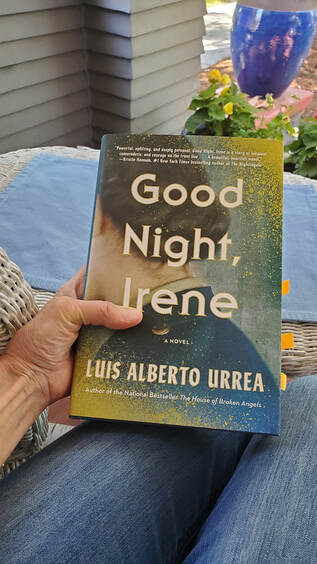|
I was thrilled to take part in a wonderful event! Pulitzer Prize finalist Luis Alberto Uurea came through Spokane, WA, on tour publicizing his newest book Good Night, Irene. Very soon after starting to read this novel, I wished that I had written it, or rather, written a nonfiction book about the Donut Dollies of World War II. These women served coffee, donuts and a slice of home to soldiers on the front lines of battle. I could not have written this book because Luis Alberto Uurea based it on the true-life experiences of his mother, Phyllis Irene McLaughlin, who traveled across Europe with Patton's army. It's a great adventure story of women's strength, friendship and sacrifice.
The fictional account follows closely the actual service route traveled by Phyllis and her Courage wears many different faces, as shown in the varied stories I've sent you, as well as in my books. This week, one woman's story moves a step beyond, showing how courage can lead to transformation. Patty Bear grew up in the Mennonite faith which holds pacificism as a foundational belief, but the cruel truth? Violence ruled her home and family. In retrospect, she called her father a "domestic terrorist" who abused her mother for years. But when he questioned Mennonite leaders and was excommunicated, the media portrayed him as the victim, a man shunned by his wife and children. Patty went from her sheltered, rural life where her father regarded her mother as property, like another animal on his farm, to becoming a pioneering woman pilot in the United States Air Force. That's transformation!
Patty agreed to tell her story for us this week. Patricia Bear: Soaring to Freedom Transformation is a lovely concept, but someone should warn us it won’t just change our circumstances, it will change who we are. And that will be a terrifying journey into the unknown. There's a new book out featuring one of my favorite historical women, Gerda Taro. I've written about her before, telling you about her incredible courage and how she believed photographs could change the world. In the mid-1930s, Gerda Taro served as a midwife of sorts, helping birth the powerful force of modern photojournalism. The new book is historical fiction based on Gerda's life. One Last Shot is a novel written in verse by Author Kip Wilson. I was immediately drawn to Kip because she has also written a book based on the life of Sophie Scholl, another young woman I've written you about and admired since I was 12 years old.
So it is with great pleasure that I welcome Author Kip Wilson to tell you about her new book and her journey writing it. (All the way to the fields of the Spanish Civil War) Take it away, Kip... Two great books for you today!
Both historical novels for young people feature Ukrainian protagonists and are based on true events during and prior to WWII. Working on the book Irena's Children, I learned for the first time the extent of the Nazi war crimes against the Polish people. The total lives lost in Poland during WWII is estimated at least five million most of whom were civilians, about 17% of the population. And now I learn that a similar number of Ukrainians died in the conflict. Approximately every fifth Ukrainian was killed during the Second World War. Only 3% of all those called up to military service for the summer of 1941 survived. The good news behind these horrendous statistics is the incredible human spirit of those who survived, their courage to rebuild their communities and their country. It definitely adds context to the endurance of Ukrainians today. This morning I woke up to this report from CNN: I had no understanding until recently of "barrage balloons" nor their importance in the success of the Normandy invasion.
And further, I had no idea of the crucial D-Day role played by black soldiers landing on Omaha Beach. This bit of forgotten history was brought to my attention by long-time newsletter reader Norm Haskett. Norm is the creator of the incredible website The Daily Chronicles of WWII, possibly the most thorough collection of WWII information on the web. Who better to fill in for me this week while I'm on vacation? |
I'm fascinated to discover little-known history, stories of people and events that provide a new perspective on why and how things happened, new voices that haven't been heard, insight into how the past brought us here today, and how it might guide us to a better future.
I also post here about my books and feature other authors and their books on compelling and important historical topics. Occasionally, I share what makes me happy, pictures of my garden, recipes I've made, events I've attended, people I've met. I'm always happy to hear from readers in the blog comments, by email or social media. Archives
September 2023
Categories
All
|




